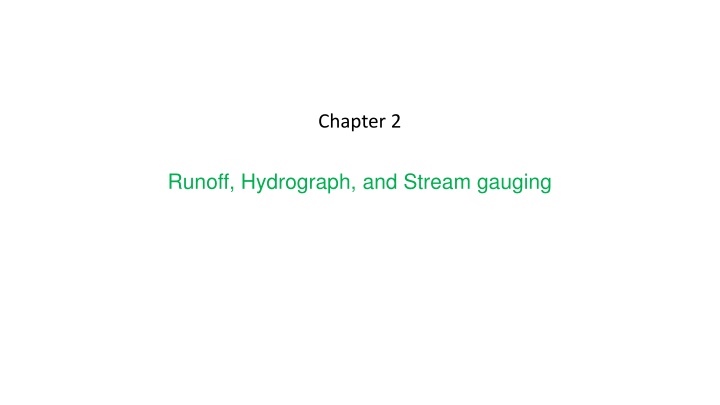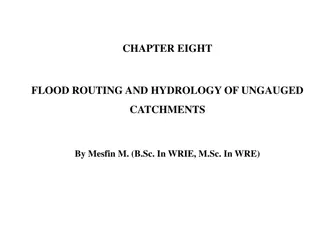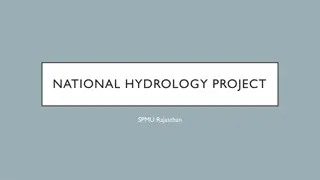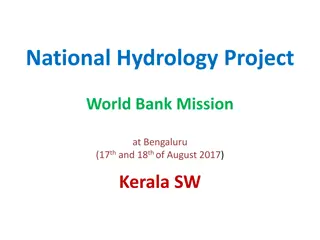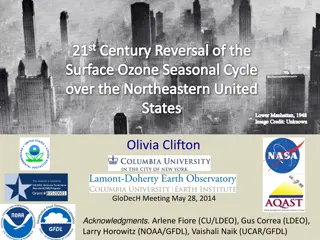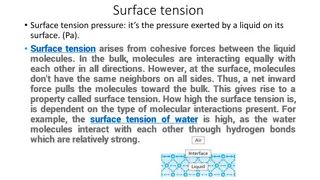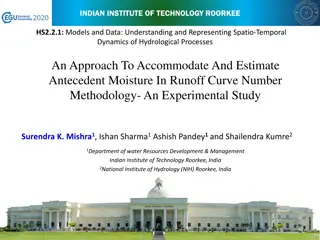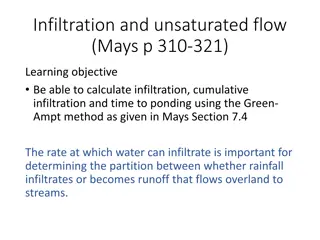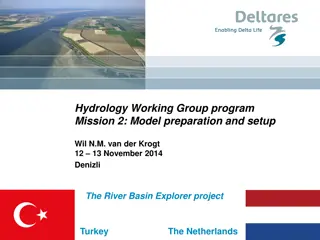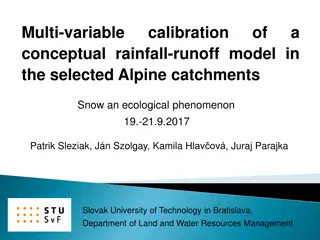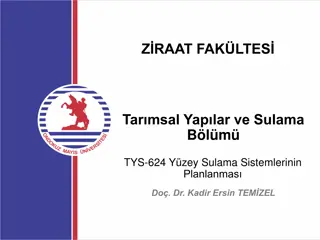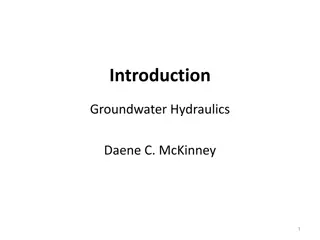Runoff and Surface Runoff in Hydrology
Surface runoff and runoff are fundamental concepts in hydrology, describing the flow of water in drainage basins and streams. Runoff represents the total water flow, while surface runoff specifically refers to water reaching streams without percolating. Understanding these terms is crucial for analyzing water movements in watersheds.
Download Presentation

Please find below an Image/Link to download the presentation.
The content on the website is provided AS IS for your information and personal use only. It may not be sold, licensed, or shared on other websites without obtaining consent from the author.If you encounter any issues during the download, it is possible that the publisher has removed the file from their server.
You are allowed to download the files provided on this website for personal or commercial use, subject to the condition that they are used lawfully. All files are the property of their respective owners.
The content on the website is provided AS IS for your information and personal use only. It may not be sold, licensed, or shared on other websites without obtaining consent from the author.
E N D
Presentation Transcript
Chapter 2 Runoff, Hydrograph, and Stream gauging
Definitions What is runoff? If the rain intensity continuous to exceed the infiltration capacity of the soil, the difference appears as rain fall excess, which initially accumulates on the ground as surface detention, and then flows as overland flow on the basin surface before entering a stream channel. The water that reaches the stream channel of a basin after fulfilling the interception, depression storage and infiltration needs of the basin is called surface runoff. The amount of water within a river or stream is of great interest to hydrologists.
Runoff and surface runoff are two different terms and should not be confused. Runoff includes all the water flowing in the stream channel at any given section. Surface runoff includes only the water that reaches the stream channel without first percolating down to the water table. Surface runoff is also called as Direct Runoff (DRO); and Runoff is also called as Discharge or Stream flow.
Yield of a Drainage Basin Yield of a drainage basin is the same as runoff, with the only difference that it is expressed over long periods, while the runoff is expressed for short periods, Thus, the yield = the total volume of water flowing per year, such as Mcum/year; while the runoff is the instantaneous rate expressed as volume of water flowing at a given section of the river in one second or one hour, such as in m3/s or m3/hr.
Constituents of Surface Runoff Surface runoff is the water that reaches the stream channel without first percolating down to the water table this may be divided into two parts: True surface runoff = Water flows directly over the ground surface. sub-surface runoff/stream flow = A part of the water that infiltrates through the soil moves laterally and before joining the water tables joins the river channel. Since it reaches the stream so quickly that it is difficult to distinguish it from true surface runoff and the ground water flow is often time long delayed before it reaches the stream. For this reason, sub-surface runoff is always treated as a part of surface runoff.
Constituents of Runoff The runoff of a river stream consists of the following three constituents: Direct precipitation over the surface of the stream. Surface runoff consisting of Constituents of Surface Runoff and of Runoff true surface runoff and sub- surface stream flow. Ground water inflow, popularity called base flow.
The Direct precipitation provides a very small portion of the total flow that depends upon the lake area of the stream channel. However; the evaporation from those water surfaces may nearly or more than balance the precipitation on them and therefore, be ignored. Hence, the runoff of a river can be supposed to be consisting of surface runoff and ground water inflow only and it can write as: Runoff = Surface runoff + Ground water inflow (i.e. Base flow)
Thus, total streamflow hydrographs are usually conceptualized as being composed of: Direct Runoff, which is composed of contributions from surface runoff including quick interflow. Baseflow, which is composed of contributions from delayed groundwater flow.
HYDROGRAPHS Components of hydrograph A hydrograph is a graph showing discharge versus time or A hydrograph is a plot of stream discharge as a function of time The various components of a natural hydrograph are shown in the following figure At the beginning, there is only base flow gradually depleting exponentially. After the storm commences, the initial losses like interception and infiltration are met and then the surface flow begins. The hydrograph gradually rises and reaches its peak value after a time tp(called lag time or basin lag) measured from the centroid of the hyetograph of net rain.
Thereafter it declines and there is a change of slope at the inflection point, where there is gradual withdrawal of catchment storage. the ground water table declines and the hydrograph again goes on depleting in the exponential form called the ground water depletion curve or the recession curve. If a second storm occurs now, again the hydrograph starts rising till it reaches the new peak and then falls and the ground water recession begins
In general hydrograph has the following major components Rising limb Ascending portion representing rising discharge due to gradual increase in flow in stream Slope depend on storm and basin characteristics Crest Segment Indicate the peak flow Controlled by storm and watershed characteristics Multiple peaks due to occurrence of two or more storms of different intensities in a closer interval
Falling limb) limb (recession From point of inflection at the end of crest segment to base flow. Inflection point indicate the time at which rainfall stopped Shape independent on storm characteristics but dependent on watershed characteristics
Factors affecting runoff and its hydrograph The main factors affecting runoff: Drainage characteristics: basin area, basin shape (form and compactness), basin slope, soil type and land use, drainage density, and drainage network topology. Most changes in land use tend to increase the amount of runoff for a given storm. Rainfall/climatic characteristics: rainfall intensity, duration, and their spatial and temporal distribution; and storm motion, as storms moving in the general downstream direction tend to produce larger peak flows than storms moving upstream.
Watershed Factors that Affect Runoff (contd) Size- area of watershed Shape of watershed Topography slope of watershed Aspect of watershed Geology Soil Land cover
Effect of watershed area 1mm of rain on 1km2 of watershed represents an input of 1,000 m3 of water or about 250,000 gallons of water. If a watershed, of 10 km2 receives an annual precipitation of 300 mm, it is inputting about 3.0 1 billion m3. Small basin flow dominated by overland flow that joins channel quickly, peak flow occur quickly
Drainage density and channel frequency Drainage density affects travel time of precipitation to channel
Higher the drainage density, quicker the peak flow, recession limb is steeper with narrow hydrograph Lesser the drainage density, slow moving rising limb and wide base width
Stream slope affects stream velocity More the stream slope higher the slope of recession limb, reduce base width of hydrograph Small slope make recession limb flatter, base width wider Nature of valley Greater valley slope higher the slope of recession limb Landuse Vegetation increases loss of water Higher the vegetation density, lesser the peak flow Surface depression Presence of ponds delay and modify flow pattern Decreases peak flow and wide base width
Climatic factors Form of precipitation Rainfall and snow fall rainfall tends to produce runoff rapidly generating hydrograph with high peak and narrow base Rainfall Intensity Affect volume of runoff , occurrence of peak flow, duration of surface flow Higher the intensity quicker the peak flow and conical hydrograph Duration of rainfall Longer the duration more the volume Longer duration, peak flow occur after longer time and hydrograph is flatter with broad base
Distribution of rainfall When heavy rain occur near outlet oPeak flow occur quickly When heavy rain occur in upper areas oPeak flow occur after few hours oLower peak and broad base (more time taken for flow to reach outlet) Direction of storm movement Affects amount of peak flow and surface flow duration Upward direction lower peak and broad base Downward direction sharp peak and narrow base
Distribution of rainfall and runoff hydrograph Runoff Hydrograph affected by movement of rainfall
STREAM GAUGING Methods of measuring stream flow oThe most satisfactory determination of the runoff from a catchment is by measuring the discharge of the stream draining it, which is termed as stream gauging. oStreamflow is the heartbeat of a watershed oA gauging station is the place or section on a stream where discharge measurements are made.
Continuous Measurement - Water Level Recorders The Stage of a Stream Float moves up / down with water surface
How do we measure how much water is in a stream? Volumetric measurements- Work on very low flows, collect a known volume of water for a known period of time Volume/time is discharge or Q Cross-section/velocity measurements Dilution gaging with salt or dye Artificial controls like weirs Empirical equations, e.g. Manning s equation
Velocity Area Method of discharge measurement By measuring the cross-sectional area of the stream and the Average stream velocity, you can compute discharge Q = VA units are L3/t (volume / time) Where Q is discharge V is velocity A is cross-sectional area
0.6 depth If stream is deep, take average of measurements at 0.2 and 0.8
(1) Three-points measuring method Vm = 0.25 ( V0.2 + 2V0.6 + V0.8 ) (2) Two-points measuring method Vm = 0.50 ( V0.2 + V0.8 ) (3) One-point measuring method Vm = V0.6 (4) Surface measuring method Vm = 0.8 Vs where, Vm: Mean velocity Vs: Surface velocity V0.2: Velocity at the depth of 20% below the water surface V0.6: Velocity at the depth of 60% below the water surface V0.8: Velocity at the depth of 80% below the water surface
The cross section of the stream at the gauging site is divided into elemental strips of equal width b and the current meter is lowered to a depth of 0.6 d below water surface in shallow depths (one-point method) and to depths of 0.2d and 0.8d (two-points method) in deep waters, at the center of each strip the mean velocity is taken as that at 0.6d below water surface in shallow water (one-point method), and the average of the velocities at 0.2d and 0.8d below the water surface (two- point method) in deep waters The discharge in each elemental strip is determined and the discharge in the stream is the sum of the discharges in all the elemental strips.
I. Mid-section method. In this method, the vertical in which the velocity measurements are made (by one-point or two-points method) is taken as the middle of the strip, and the water depth (d) in the vertical (determined by sounding) is taken as the mean depth of the strip If b is the width of strip (usually same for all strips) then the discharge in the elemental strip is given by: stream discharge, Q = Q In this method, the discharge in the two-triangular bits near the ends are not included in the discharge computation
II. Mean-section method. In this method, the elemental strip is taken between two verticals and the mean depth is taken as the average of the depths in the two verticals (determined by sounding). The width of the strip is distance b between the two verticals. The velocity in the strip is taken as the average of the mean velocity determined in the two verticals (by one-point or two-points method)
The discharge in the elemental strip is given by The mean section method is considered to be slightly more accurate, but the mid- section method is faster and is generally used.
